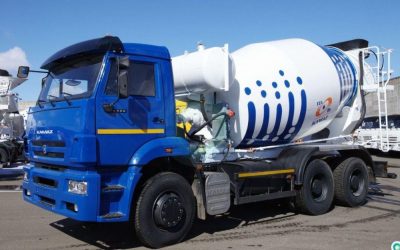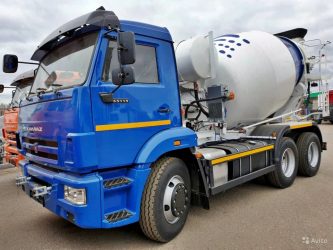To build a private house, cottage, barn, temporary shed or any other structure, it is necessary to calculate the material. For people who decide to do this business on their own, it is important to understand how the process works. You can mix the concrete mixture yourself (rent a concrete mixer, mix it by hand) or order ready-made material. It’s easier and faster to use the second option, which is why most builders choose it. It is also worth remembering that the durability and reliability of the building depends on the quality of the mix. So, you want to order ready-made concrete, but you don’t know how many cubes of mixture are in the concrete mixer. After reading this article, you will find out how many cubes of concrete are in the mixer.
Advantages and features of the mixer
Today, almost every enterprise involved in reinforced concrete has concrete mixer trucks and concrete trucks. It will be useful for a potential buyer to know that payment is calculated separately for the production of material, its delivery and downtime of equipment. Professionals recommend choosing a mixer. Using this technique, you can get the material of the desired quality, and it will cost less.
Let's look at the advantages of a mixer:
- high quality concrete mixture, a drum used as a working element allows you to obtain a homogeneous mass in a short time;
- a mixer is easier and cheaper to rent than a concrete truck, and you can also prepare the solution yourself from your own components;
- in addition to delivery, you can order pouring of concrete mixture in the required quantity;
- The mixer is suitable for creating concrete of any brand; the working element will crush and mix crushed stone of any hardness.
Reference! The mixer (concrete mixer truck) for mixing building materials is made on the basis of a car chassis. The working part consists of the following elements: an unloading module, a drum, a rotating device and a screw mixer.
How many cubes of concrete are in a car mixer mixer?

When carrying out large volumes of construction work, in cases where the preparation of concrete on site is associated with significant difficulties, truck mixers are the only solution. To optimize work, a necessary parameter is equipment productivity, which shows how many cubes of concrete in a mixer can be prepared and transported in one trip.
What is a car mixer?
The mobile mixer is based on a car chassis. The working part itself, in which the solution is prepared and transported, consists of several main elements:
- mixer drum;
- screw mixer;
- a device that ensures rotation of the drum;
- unloading module.
Operating principle
When preparing a working mixture, one of the most important factors affecting the quality of the final product is uniform mixing of the loaded components. This is ensured by the presence of a rotating drum and a screw mixer.
Structurally, the stirrer is made in the form of a fixed Archimedean screw. Mixing is carried out by rotating the drum. When loading the initial components, due to rotation, the mixture is pushed along the surface of the screw deep into the container and mixed until homogeneous.
In order to unload the finished solution, the direction of rotation of the drum is reversed. The screw attachment, due to the rotation of the drum, in this case will empty the entire volume of the mixer, actually pushing the blades with concrete out.
Equipment classification
There are a very large number of modifications of car mixers. The differences lie in a number of technological and design parameters:
- wheelbase type;
- capacity of the mixer working container;
- method of unloading the solution;
- organization of drum rotation;
- optional equipment.
Wheelbase
Mobile concrete mixers are produced on the basis of various vehicle chassis. The most popular are domestic KamAZ models; there are also wheelbases produced by ZIL and Ural. How much concrete goes into a mixer made on the basis of a KamAZ vehicle or other manufacturers depends on the volume of the drum.
Among foreign analogues, we can note the chassis produced in the Republic of Belarus (MAZ, BelAZ), Germany (MAN, Mercedes), Sweden (Volvo, Scania), Japan (Nissan, Mitsubishi). Less common, but still sometimes found, are imported chassis made in Ukraine, Italy, the USA, and Korea.
Mixer volume
The main parameter that influences how many cubes of concrete can be prepared and transported in one mixer is the volume of the working drum. Today, a number of standardized values have emerged that cover basic production needs.
Domestic manufacturers produce cars with drum volumes of 2, 4, 5, 6, 7, 8, 9, 10, 11 and 12 m3. The mixer volume most popular for transporting concrete is 5, 7 and 9 m3. Of the foreign models, the most common are cars capable of preparing and transporting 6 m3 of solution.
Unloading method
Structurally, two types of unloading can be distinguished:
In the first case, the concrete solution is unloaded through the neck located at the rear of the mixer. This type is more reliable and is widely used in domestic equipment.
The front type of unloading is common among foreign manufacturers. This organization of the process allows the driver to control the unloading process directly from the vehicle cabin.
Rotation drive
The rotation of the mixing drum is carried out by a motor with a mechanical or hydraulic drive. The engine can be made in a combined (combined) design. It distributes the power expended to move the car and to rotate the drum. A more reliable option would be to use an autonomous engine, the torque of which is used entirely for mixing the concrete mass and unloading the solution.
Optional equipment
Many models include additional equipment:
- extended chute for unloading solution (length from 1.5 to 2 m);
- concrete pump;
- sliding tower with a sleeve for pumping solution to a height.
Nuances of work
Despite the apparent simplicity of the process of using a car mixer, there are a number of subtleties that must be taken into account:
- during long-term transportation, the concrete solution is prepared directly in the mixer;
- during the cold period, in addition to the usual components, chemical reagents are introduced into the mixture to prevent rapid freezing.
Calculation of the amount of solution
An important issue remains determining the actual amount of mixture in the mixer. It is clear that it is unlikely that it will be possible to load 6 m3 into a container with a volume of 5 m3, but less often happens. In order not to overpay for air, it is useful to know the ways in which you can determine how much concrete is in the mixer.
By weight of the shipped mixture
If the enterprise weighed the shipped solution, then the actual volume of concrete can be calculated quite easily. To do this, you need to divide the mass of the solution by its density. Approximate density values for various concretes will be as follows:
- 1800–2500 kg/m3 – heavy concrete with crushed stone or gravel filler;
- 500-1800 kg/m3 – light gas-filled concrete with expanded clay, vermiculite, etc. filler;
- less than 500 kg/m3 – ultra-light gas and foam concrete.
By emptying time
Another method by which you can approximately determine the volume of concrete solution prepared in a KamAZ mixer is based on an estimate of the emptying time (unloading 1 m3 takes about 5 minutes). Accordingly, unloading a mixer with a volume of 5 m3 will approximately take about 25 minutes.
Useful tips
When choosing a vehicle for transportation, you should pay attention to the cleanliness of the surface of the internal walls of the mortar drum. If after unloading the insides were not washed with water, then part of the solution will certainly remain there, which dries out quickly enough.
Over time, the mass of residues will only increase, and determining how much concrete is actually contained in the KamAZ mixer will be problematic. In addition, a large amount of solidified mortar on the walls can interfere with the rotation of the drum and, as a result, reduce the uniformity of mixing and the quality of the final product.
Source: https://tehno-beton.ru/beton/betonirovanie/skolko-kubov-v-miksere.html
Number of cubes in the mixer
To understand how many cubes of concrete mixture are in the mixer, you first need to understand its basic parameters. Mixers differ in sleeve length, drum capacity (the question that interests us) and weight. It is according to these parameters that special equipment is classified. It all depends on the manufacturer and model of the mixer; modern equipment is equipped with drums from 2 to 15 cubic meters . You can determine how much concrete is in the KAMAZ mixer on site. As for the optimal options, the volume of their drums is 5 and 7 m3. Mixers with a volume of 4.6 and 9 cubic meters are less often required.
If you request a service from a company that deals with reinforced concrete, they will most likely have the following mixer options:
- models with a length of 5.5 m and a volume of 2-4 m3;
- models with a length of 7.5 m and a volume of 7-9 m3;
- models with a length of 9.5 m and a volume of 10-12 m3;
- models with a length of 11.5 m and a volume of 15 m3.
It is also worth considering weight. For example, a 5-cube mixer weighs 11 tons, a 7-cube model weighs 12 tons. As for the weight of the concrete mixture, it is 2.4 tons. If you take a filled 7-cube mixer, it will weigh about 30 tons. Why is this information needed? The fact is that not every construction site or construction coating can withstand such heavy equipment. If it is not possible to accept such a machine, then you should think about delivering the material in parts.

The length of the sleeve must also be taken into account. The concrete will flow down the sleeve (gutter) into the desired container. The average sleeve length is 1.5-2 meters. In some cases, additional devices are required to extend the gutter. This issue needs to be discussed in advance, since there is a separate payment for additional structures. The width of a concrete mixer truck is usually standard - 2.5 m. An exception may be large equipment with a capacity of 15 cubic meters or more.
How many cubes of concrete are in a KamAZ mixer - types and their parameters

When constructing monolithic foundations, plinths, floors, blind areas, constructing platforms or paths, a large amount of concrete must be poured. If the portions are small and the work is extended over time, weakened areas will form in the structures. A solution laid on an already set dried layer does not form a single whole with it. This deteriorates the quality of concreting, leads to the formation of cracks, cavities, reduced service life and loss of load-bearing capacity of critical elements.
You can prepare the concrete mixture yourself, but a large volume is often beyond the power of a home concrete mixer. To make the task easier, ordering material delivery by concrete mixer truck will help. In order for the entire delivered solution to go into use, so that excess does not form or additional portions are not required to be mixed, you need to know how many cubes of concrete fit in the KamAZ mixer.
What are the advantages of ordering a mixer?
Concreting is a labor-intensive and difficult process. It is necessary to deliver the components to the construction site - cement, sand, crushed stone. To prepare the solution, you need to measure and load the components, mix, take to the place in buckets or a wheelbarrow, and pour into the formwork. There are often difficulties with water supply. Often there is no well or well on the territory of a new building. They use imported water, which is stored in containers.
If the volume of work is large, it is advisable to order delivery of concrete in a mixer truck. The mixture is produced by reinforced concrete factories or small specialized enterprises. Benefits that the developer will receive:
- fresh mixture will be delivered to the site;
- the grade of concrete will correspond to GOST;
- the solution can be immediately placed in the formwork;
- the mixture is supplied to the working area through a chute, which reduces the share of manual labor;
- monolithic work will be carried out quickly, there will be no extra seams or areas with poor-quality concreting;
- labor intensity will be significantly reduced.
Concrete transported in a mixer retains its homogeneity, mobility, and does not delaminate. Some models are equipped with hoses and pumps to move the mixture several meters.
Types of mixers and their parameters
Concrete mixer trucks are trucks with a rotating pear-shaped mixer for transporting mortar or concrete. According to GOST 7473-2010, the mixture upon delivery should not be exposed to precipitation or lose homogeneity. Leakage of cement mortar, exceeding the time of maintaining mobility, and the original strength of the material are not allowed. To prevent delamination, premature setting or freezing, plasticizers are added to the composition.
The Kama Automobile Plant produces gravity reversible ABS models based on the KamAZ 65115, 69343, 63963, 53229-15 and others chassis, with various technical characteristics and a mixer volume of 5-12 m³. The most popular equipment is with a pear size of 9 m³.
Modern ABS are equipped with a hydraulic drive of mixing equipment, which replaced the mechanical control method. Mixing after loading is ensured by the rotation of the drum, inside of which spiral blades are located. Unloading is carried out in the forward or backward direction with the reverse movement of the blades. Modern technology delivers the solution to the site at temperatures from -30°C to +40°C.
Concrete can be prepared in two ways:
- loading dry components, mixing them with water from a car tank and mixing during transportation;
- pouring the finished mixture at the factory or BRU and delivery to the site.
For the convenience of supplying concrete from ABS, use:
- standard or extended gutters with a length of up to 7 m;
- pipes, sleeves;
- concrete pumps;
- conveyor belts with unloading up to 14 m.
The use of a telescopic boom increases the feed length to 60 m.
The volume of concrete in the mixer is not equal to the geometric volume of the drum; it is determined by the yield of the finished mixture or capacity. Free space is necessary for free mixing of the solution inside the device. According to GOST 27339-93, the difference is from 4 to 6 cubic meters.
Mixer capacity is a factory technical characteristic that determines the maximum load of a concrete mixer truck. In fact, the required amount of the mixture is delivered to the customer, which is paid separately from the transportation price. A KamAZ mixer with a geometric volume of 8 m³ can actually contain no more than 5 m³ of concrete. This is due to the carrying capacity and capabilities of the vehicle chassis.
To order delivery of concrete using a mixer, you must first calculate the required quantity based on the actual dimensions of the formwork or area for pouring. It may differ from the design one up or down.
To ensure that the structure retains its solidity, concreting is carried out as quickly as possible.
If there is a shortage, you will have to additionally deliver the solution to the site in emergency mode, prepare it in an electric concrete mixer or manually, and this is always an overpayment. Transportation costs do not depend on the volume of material in the mixer, but only on the distance. Excess concrete is also an unnecessary expense, and you also need to find a place to unload it somewhere.
Before pouring concrete, the formwork must be installed, exposed, and the reinforcement cage must be laid. All sizes are carefully measured with a tape measure. The volume is found by knowing the length, width and height of the structure, without deducting the space occupied by the metal rods.
Construction sites offer online calculators for calculating concrete, which take into account the geometric dimensions of structures.
To determine how many cubes of mixture are actually required, builders recommend increasing the “net” volume by 8-10%.
When ordering delivery of the mixture with a mixer, you need to prepare:
- Provide access roads for ABS. If the volume of monolithic work is large, it is worth identifying several points for unloading.
- The site for parking the ABS, from where the supply will take place, is selected no closer than 8 meters from the edge of the pit. The slope should not exceed 5%, dimensions should not be less than 6x8 meters.
- It is advisable to use a vibrating tool to compact the concrete mixture. This will improve the quality of work.
- Provide a place for draining excess mortar - install formwork, waterproofing and reinforced frame for secondary structures - a fence or barbecue. Place the remaining unused concrete in the prepared form.
- To avoid underloading, order delivery only from trusted suppliers. Usually these are large manufacturing plants.
- Plan delivery for the morning in order to have time to use up the entire amount of mixture brought.
- For large volumes of monolithic work, create a schedule for the arrival of mixers, which should not be too tight. It is better to leave a gap of at least 2 hours between flights.
- The ABS driver is required to provide a consignment note and a quality certificate for concrete indicating the volume and brand.
Features of working with a mixer that must be taken into account
These nuances primarily apply to people who plan to rent a mixer for independent work. If the equipment is used for too long, the mixture dries out on the walls of the drum, as a result, the capacity of the mixer is reduced. If you order such equipment for 5 m3, in the end you will only get 4-4.5 cubic meters. Choose a mixer yourself; it must be well-maintained and frequently used. The gutter and concrete must be thoroughly washed with water after each unloading of the solution. Prepare in advance the area where the water and the remaining working material will drain.
Helpful information! You can check the delivered volume of concrete based on the unloading time. One cubic meter of concrete mixture is drained in about 10 minutes. Accordingly, it will take 50-60 minutes to unload 5 cubes.
What happens if you order 6 cubes in a mixer that is designed for 7 cubes? It all depends on the company's approach. Most often you have to pay an additional “fine” for underloading. Such nuances must be discussed in advance so as not to pay extra money. You can always find another company whose garage will have the equipment you need. At the end, it’s worth returning to the topic of the article – the volume of concrete in the KAMAZ mixer. It all depends on your experience, but it is better to entrust this task to a professional.
How many cubes of concrete are in 1 Kamaz mixer?

Domestic manufacturing companies that produce mixers based on the KAMAZ vehicle chassis equip them with “concrete mixers” designed for a volume of material from 5 to 10 m3.
At the same time, the most popular mixer drum volumes are: 5, 7 and 9 m3. At the same time, domestic companies produce drums designed to deliver: 2, 4, 5, 6, 7, 8, 9, 10, 11 and 12 cubic meters of concrete in one trip.
Advantages of buying concrete in mixers
- Possibility of prompt provision of concrete for both small private construction projects and large-scale constructions;
- Possibility of delivering material over long distances without fear of exposure to harmful atmospheric factors;
- Possibility to fill the structure simultaneously with unloading;
- Possibility of purchasing specified volumes of concrete.
Nuances when delivering concrete by mixers
By calculating the volume of concrete to be poured and knowing how many cubes of concrete are in the Kamaz mixer of the material manufacturer you hired, you can simply and quickly calculate the number of trips. However, we must take into account the fact that some suppliers are dishonest, resulting in violations of equipment care rules. So, if the inner surface of the mixer drum is not washed after draining the load, the concrete remaining on its walls hardens and significantly reduces the amount of “usable” material for subsequent deliveries.
There are two ways to check the integrity of a company. The first way is to personally go to the production site and see how the drums are (or are not) washed and the material loaded. The second way is to calculate the amount of concrete delivered using the following simple technology:
- Approximate calculation based on the weight of concrete. According to trade rules, the machine must be “packed” (weighed) before loading the material. After loading, the machine is weighed again, and the amount of loaded material is indicated on the cargo bill. Knowing the weight of the material, you can calculate its volume. To do this, the mass of the solution in kilograms (from the invoice) is divided by the approximate density of concrete in kg/m3: 1800-2400 kg/m3 – heavy concrete; 500-800 kg/m3 lightweight concrete, 500 kg/m3 foam and ultra-lightweight concrete;
- By unloading time. On average, 1 m3 of concrete is unloaded within 10 minutes. Therefore, you can stand near the machine, note the time of unloading the machine in minutes and divide the resulting figure by 10 to determine how many cubes of material were brought to you (or not brought).
Moreover, both methods of verifying the integrity of a company can be implemented simultaneously, independently of each other. Such a check is especially relevant if you buy a significant amount of construction material - several or several dozen KAMAZ flights.
You can also ask if the company has a GPS tracking system for vehicle movement. As a rule, conscientious companies have such a system, which completely eliminates the partial unloading (theft) of material by the driver on the way to the customer.
Source: https://salecement.ru/skolko-kubov-betona-mozhet-dostavit-mikser-kamaza-za-odnu-hodku/
